Advertisements
Advertisements
प्रश्न
Consider the situation shown in the figure. The two slits S1 and S2 placed symmetrically around the central line are illuminated by a monochromatic light of wavelength λ. The separation between the slits is d. The light transmitted by the slits falls on a screen ∑1placed at a distance D from the slits. The slit S3 is at the central line and the slit S4 is at a distance z from S3. Another screen ∑2 is placed a further distance D away from ∑1.Find the ratio of the maximum to minimum intensity observed on ∑2 if z is equal to
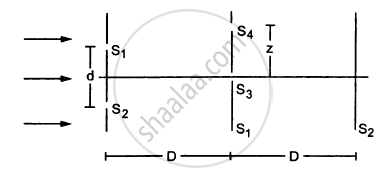
(a) \[z = \frac{\lambda D}{2d}\]
(b) \[\frac{\lambda D}{d}\]
(c) \[\frac{\lambda D}{4d}\]
उत्तर
Given:
Separation between the two slits = d
Wavelength of the light = \[\lambda\]
Distance of the screen = D
The fringe width (β) is given by \[\beta = \frac{\lambda D}{d}\]
At S3, the path difference is zero. So, the maximum intensity occurs at amplitude = 2a.
(a) When \[z = \frac{D\lambda}{2d}\]
The first minima occurs at S4, as shown in figure (a).
With amplitude = 0 on screen ∑2, we get
\[\frac{l_{max}}{l_{min}} = \frac{\left( 2a + 0 \right)^2}{\left( 2a - 0 \right)^2} = 1\]
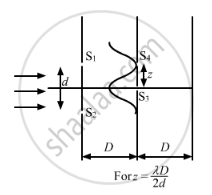
(b) When \[z = \frac{D\lambda}{d}\]
The first maxima occurs at S4, as shown in the figure.
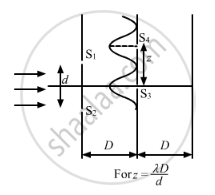
With amplitude = 2a on screen ∑2, we get
\[\frac{l_\max}{l_\min} = \frac{\left( 2a + 2a \right)^2}{\left( 2a - 2a \right)^2} = \infty \]
(c) When \[z = \frac{D\lambda}{4d}\]

The slit S4 falls at the mid-point of the central maxima and the first minima, as shown in the figure.
Intensity \[= \frac{l_\max}{2}\]
\[ \Rightarrow \text{Amplitude }= \sqrt{2}a\]
\[\therefore \frac{l_\max}{l_\min} = \frac{\left( 2a + \sqrt{2}a \right)^2}{\left( 2a - \sqrt{2}a \right)^2} = 34\]
APPEARS IN
संबंधित प्रश्न
When monochromatic light is incident on a surface separating two media, the reflected and refracted light both have the same frequency as the incident frequency.
Two monochromatic rays of light are incident normally on the face AB of an isosceles right-angled prism ABC. The refractive indices of the glass prism for the two rays '1' and '2' are respectively 1.3 and 1.5. Trace the path of these rays after entering the prism.
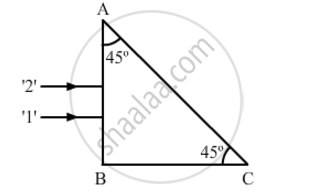
Two monochromatic rays of light are incident normally on the face AB of an isosceles right-angled prism ABC. The refractive indices of the glass prism for the two rays '1' and '2' are respectively 1.35 and 1.45. Trace the path of these rays after entering the prism.
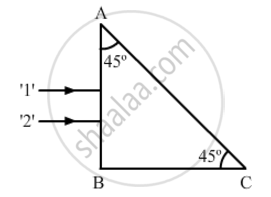
When light travels from a rarer to a denser medium, the speed decreases. Does this decrease in speed imply a reduction in the energy carried by the wave?
In the wave picture of light, the intensity of light is determined by the square of the amplitude of the wave. What determines the intensity in the photon picture of light?
A monochromatic ray of light falls on a regular prism. What is the relation between the angle of incidence and angle of emergence in the case of minimum deviation?
State the essential conditions for diffraction of light ?
When monochromatic light travels from a rarer to a denser medium, explain the following, giving reasons:
(i) Is the frequency of reflected and refracted light same as the frequency of incident light?
(ii) Does the decrease in speed imply a reduction in the energy carried by light wave?
Obtain the conditions for the bright and dark fringes in diffraction pattern due to a single narrow slit illuminated by a monochromatic source.
Explain clearly why the secondary maxima go on becoming weaker with increasing.
State Huygen’s principle. Using this principle explain how a diffraction pattern is obtained on a screen due to a narrow slit on which a narrow beam coming from a `=> n = (vlamda)/(vlamda_omega)`monochromatic source of light is incident normally.
Which of the following sources provides the best monochromatic light?
The following figure shows three equidistant slits being illuminated by a monochromatic parallel beam of light. Let \[B P_0 - A P_0 = \lambda/3\text{ and }D > > \lambda.\] (a) Show that in this case \[d = \sqrt{2\lambda D/3}.\] (b) Show that the intensity at P0 is three times the intensity due to any of the three slits individually.
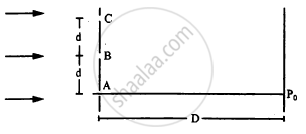
"Monochromatic light should be used to produce pure spectrum". Comment on this statement.
Can the interference pattern be produced by two independent monochromatic sources of light? Explain.
Find the angle of incidence at which a ray of monochromatic light should be incident on the first surface AB of a regular glass prism ABC so that the emergent ray grazes the adjacent surface AC. (Refractive Index of glass = 1 .56)
For constructive interference to take place between two monochromatic light waves of wavelength λ, the path difference should be ______.
Assertion(A): The photoelectrons produced by a monochromatic light beam incident on a metal surface have a spread in their kinetic energies.
Reason(R): The energy of electrons emitted from inside the metal surface, is lost in collision with the other atoms in the metal.
Monochromatic light of wavelength 396 nm is incident on the surface of a metal whose work function is 1.125 eV. Calculate:
- the energy of an incident photon in eV.
- the maximum kinetic energy of photoelectrons in eV.
